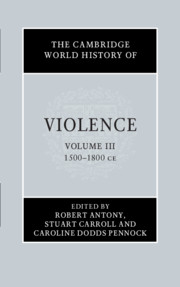Book contents
- The Cambridge World History of Violence
- The Cambridge World History of Violence
- The Cambridge World History of Violence
- Copyright page
- Contents
- Figures
- Maps
- Contributors to Volume iii
- Introduction to Volume iii
- Part I Empire, Race and Ethnicity
- Part II Cultures of War and Violence
- Part III Intimate and Gendered Violence
- Part IV The State, Punishment and Justice
- 17 Crime and Punishment in the Russian Empire
- 18 Homicide and Punishment in Eighteenth-Century China
- 19 Crime and Justice in Anglo-America
- 20 Violence and Justice in Europe: Punishment, Torture and Execution
- 21 Legitimised Violence in Colonial Spanish America
- Part V Popular Protest and Resistance
- Part VI Religious and Sacred Violence
- Part VII Representations and Constructions of Violence
- Index
- References
19 - Crime and Justice in Anglo-America
from Part IV - The State, Punishment and Justice
Published online by Cambridge University Press: 13 March 2020
- The Cambridge World History of Violence
- The Cambridge World History of Violence
- The Cambridge World History of Violence
- Copyright page
- Contents
- Figures
- Maps
- Contributors to Volume iii
- Introduction to Volume iii
- Part I Empire, Race and Ethnicity
- Part II Cultures of War and Violence
- Part III Intimate and Gendered Violence
- Part IV The State, Punishment and Justice
- 17 Crime and Punishment in the Russian Empire
- 18 Homicide and Punishment in Eighteenth-Century China
- 19 Crime and Justice in Anglo-America
- 20 Violence and Justice in Europe: Punishment, Torture and Execution
- 21 Legitimised Violence in Colonial Spanish America
- Part V Popular Protest and Resistance
- Part VI Religious and Sacred Violence
- Part VII Representations and Constructions of Violence
- Index
- References
Summary
In the Anglo-American settlements of North America the most conspicuous causes of violence were rivalries at contested frontiers, weak government, racism, race slavery, indentured servitude and class differences, and state-sanctioned war. Unrestrained by laws and magistrates, migrants to North America in the seventeenth century violently attacked Native Americans and fellow Europeans at rates as high as 200 homicides per 100,000 population. In time public authority grew and tempered egregious violence, but it did not disappear. Frontiers shifted further inland, and at contested western and southern borders it proliferated. Racism underlay much of the violence, clearly in conflicts with Native Americans, such as King Philip’s War and Pontiac’s Rebellion, and in the enslavement of Africans and the violence which maintained the subordination of African Americans. Ironically, certain populations shared race, ethnic or religious prejudice towards ‘outsiders’ and these shared prejudices moderated violent behaviour within those populations. Indentured servants comprised a large portion of the immigrant population; their disorderly and violent behaviour taxed local governments and elites over two centuries. At the end of the era the American Revolution provoked a wave of internecine violence that outlasted the conflict with England and subsided especially with the expansion of white, male democracy in the nineteenth century.
Keywords
- Type
- Chapter
- Information
- The Cambridge World History of Violence , pp. 370 - 388Publisher: Cambridge University PressPrint publication year: 2020

